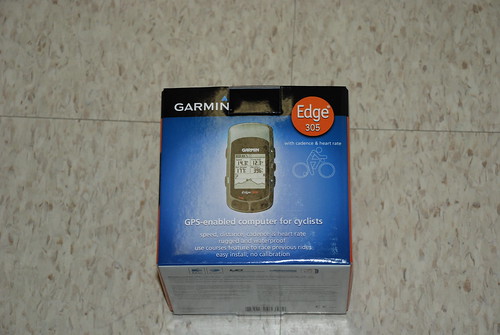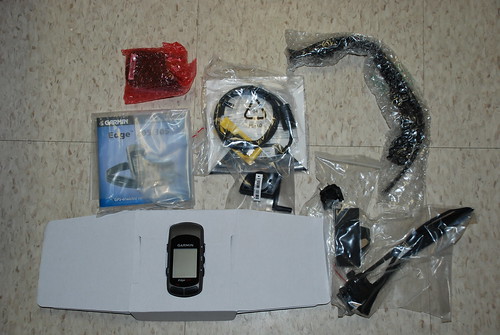I've sought long and hard to bury my inner geek. Yet no matter how much I try, my true geekiness seems to shine through from time to time. Anyone who's been on the internet should be quite familiar with fanboys blogging their glee at unboxing their newest tech-toys. Well when my Garmin Edge 305 GPS bicycle computer arrived this week, I couldn't help but share in their joy, but first a bit of background. Since the day I bought my bike, I've longed for a cyclocomputer. Basically it's a fancy speedometer for your bike that tracks statistics such as speed, mileage, and cadence. There are plenty of options on the market which can provide these features for a bargain price. However, I wanted the ability to track my routes, elevation, and most importantly progress over time. I settled on the Garmin Edge 305. Shipped to my door, the final price was $270 from Amazon.com. A bit expensive, but it has every feature I need plus Garmin Connect's online software which is perhaps the best system for tracking both routes and ride data such as speed, heart rate, and cadence.
The Cupertino influence on Garmin's packaging is very evident.
I've used my Edge once already, and have been very pleased with it. You can expect an in-depth review soon. But while I'm still trying to figure out the nuances of my GPS, I figured I'd post a little unboxing joy of my own so others who might be considering the Edge 305 would know what they're getting. My first impression was a little surprise. The box is perfectly square and reminiscent of the packaging my first Apple iPod came in. However, Garmin still has a way to go before fully realizing Apple's clean, minimalist packaging. The unit itself is tiny and light weight, with a very clean appearance. All functions are easy to use while at full speed, and the display is easy to read.
The GPS itself is tiny, with an easy to read screen.
I opted for the model complete with GPS, cadence sensor, and heart rate monitor. Cadence is an important statistic for cyclists. Novice cyclists often choose too difficult a gear and pedal at a low cadence. The problem with this strategy is that it is mostly anaerobic and quickly leads to muscle fatigue. Not good when trying to ride distances of 60-100 miles. More experienced cyclists use an easier gear and spin it at a faster cadence (90-110 rpm), utilizing more aerobic and cardiovascular endurance which can help one ride faster over longer distances.
The whole package complete withe cadence sensor and heart rate monitor.
Installation was easier than I thought. Included are all necessary mounts and zip ties for the entire system. Garmin even throws in an additional stem mount for cyclists with multiple bikes... or those who might mess up the first time. I was able to get everything attached and working within 30 minutes. The stem mount and cadence sensor go on with zip ties. The toughest part is lining up the cadence sensor, crank magnet, and spoke magnet. However the combination of green and red LED's on the cadence sensor which light up when active make setup very easy. If everything is installed correctly the entire system is unobtrusive. But anyone who has one can appreciate the aesthetics of Trek's new DuoTrap system which integrates a cadence sensor cleanly into the chainstay of the bike.
The unit in place and ready to use.
Honestly, part of me was a little afraid of getting a bicycle computer. The computer tells no lies, and as in many sports very often people's idea of how they perform is far better than reality. However, I was pleasantly surprised to see that I was very close to what I expected. My first trip out was during a recovery ride on a windy and hilly route with some quite a bit of soreness from running the previous day. I was able to maintain a 15 mph average speed at a cadence of 80 rpm. Not too bad, and thankfully exactly where I expected myself to be.




Are you loving it?
ReplyDeleteSo far I'm loving it very much. A full review of Garmin Connect and the Edge 305 is coming very soon.
ReplyDelete